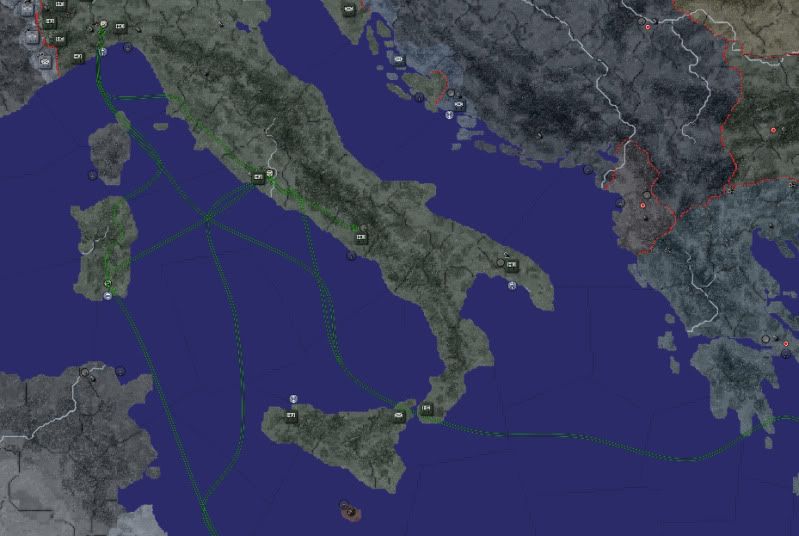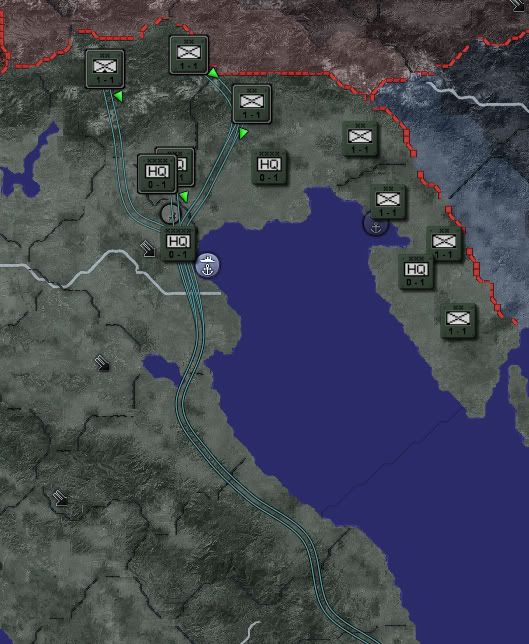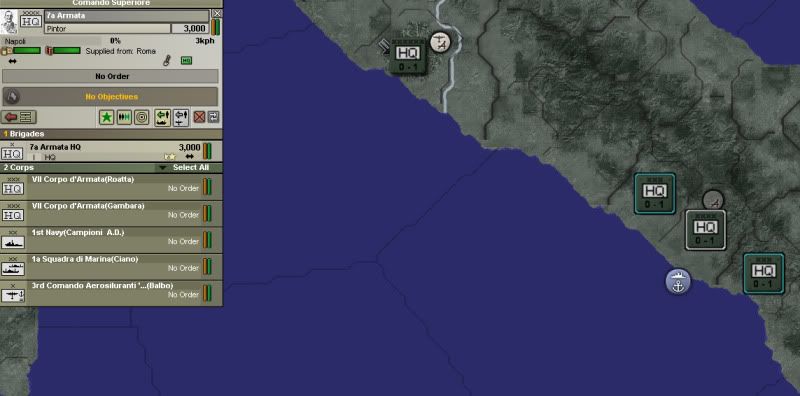The First Year of Renaissance
Part 4: Drastic Measures III, January 1 – January 17, 1936
The last of Mussolini’s initial, and drastic, measures concern the deployment of Italy’s armed forces. For the Regia Marina and Regia Aeronautica, these redeployments were comprehensive affairs that, as far as possible, either reflected Mussolini’s strategic concepts or set themselves as far away from the preceding strategic theories and practices as possible. Given the Regio Esercito’s relative lack of importance in Mussolini’s strategy of power projection and its own necessary task of guarding Italy’s borders, it was to a large extent spared the total redeployment that the navy and air force underwent. Nevertheless, though this section is limited to just seventeen days, the complete redeployment took much longer than that. The first and only stage of redeployment to take place during 1936 was, overall, more of an administrative redeployment than anything else. Certain ideas can be clearly identified behind it all, however.
When the navy received its orders of redeployment, it was, simply put, an administrative mangle. It was so far beyond being a mere tangle that it hurt to even try to figure it out, both for Mussolini then and historians now. The naval redeployment, more than any other, was founded upon administrative ease. Ships of all sorts of classes and all sorts of missions were scattered all across the handful of major Italian naval ports. To ease his anticipated second stage of redeployment, Mussolini sent specific types of ships to specific ports. Submarines went to Sardinia. Destroyers and light cruisers were sent to Savona and heavy cruisers to La Spezia. Naples was designated home to transports. The only mixed fleet left was Ghe’s fleet in Taranto, comprised of the four Italian battleships, one heavy cruiser, three light cruisers and ten destroyer flotillas. Mussolini decided to leave that fleet in place and being until the second stage; it was full of obsolescent ships anyway.
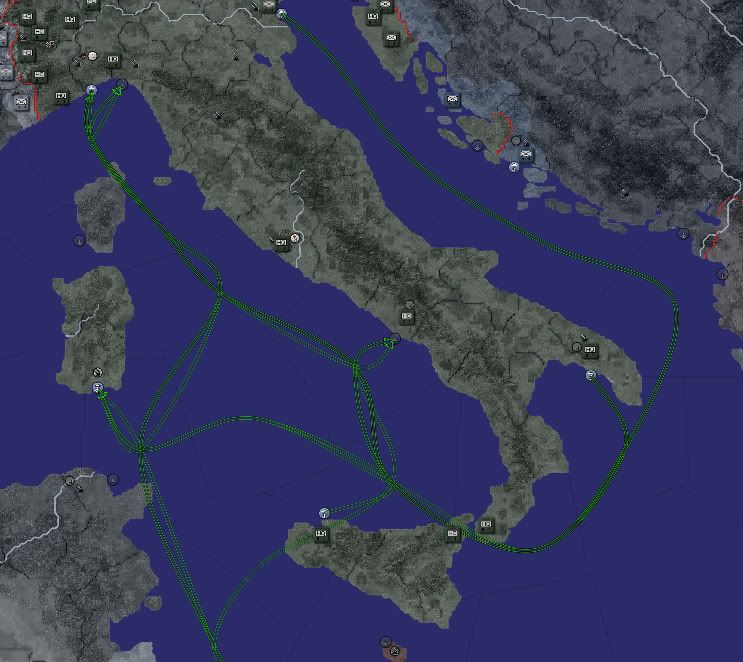
The naval redeployments.
The redeployment of the air force was much more straightforward, owing to the greatly lower number of units. The rationale behind the redeployment remained the same, however: administrative ease. Italy’s naval bombers were to be based on Sardinia, together with the one squadron of transport planes. Interceptors were sent to Savona, near the French border. Rome became home to Italy’s medium bombers, given its central location and its dual role in doctrine as air support for both armies and navies. The deployment of naval bombers to Sardinia may seem unremarkable, but it was a reflection of Mussolini’s thinking. He believed that Italy’s first opportunities besides Abyssinia would come in the western Mediterranean.
The aerial deployments.
As mentioned, redeployments affected the army the very least of all the branches of the armed forces. In the event, a single corps was redeployed. Mussolini was broadly satisfied with army deployments: the 1st and 4th Armies in the west facing France and the 2nd, 6th and 8th Armies in the east and north facing Austria and Yugoslavia. Of these latter three armies, two comprised only one corps each: Guzzoni’s 6th Army and Vercellino’s 8th Army. Of these, the 8th Army was poised to defend the Austrian border, a duty Mussolini saw as somewhat ludicrous given Italy’s position in Europe as the guarantor of Austria’s territorial integrity against Germany’s rapacious appetites. An attack from Austria was thus nearly unthinkable. Mussolini thus dissolved the 8th Army and redeployed its corps southward for other duty.
The army’s sole redeployment of the time: one corps, being the entire 8th Army.
This solitary redeployment was, however, part of a larger scheme. It was routed southward to Naples, where Pintor’s 7th Army waited. This one corps army was slated to double in size. Pintor was one of Mussolini’s trusted generals, a competent man who would not sacrifice strategy at the altar of tactics, or timidity. Mussolini’s aim was to create the basic army he would project outwards onto other shores, an army of elites. In pursuit of this ambitious goal, he hand-selected the generals to serve under Pintor all the way down to divisional level. Gambara and Roatta were chosen as corps commanders. Roatta’s divisional commanders were to be Scattini and Frattini, two mountaineers, though both received command of regular infantry divisions. Gambara’s divisional commanders were Bitossi, Caracciolo di Feroleto and the brilliant Messe. Under the command of these three men were, respectively, two infantry divisions and a mountaineer division. The 7th Army represented the greatest concentration of command talent in the entire Regio Esercito.
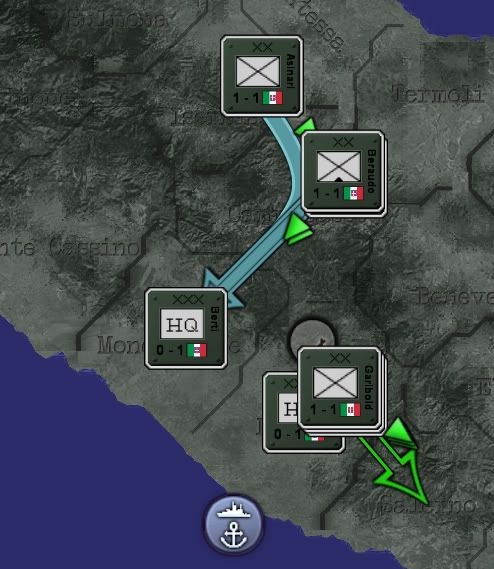
The final redeployment of the one corps of the 8th Army to Naples
After Mussolini accomplished the deployment of the 7th Army around Naples, he turned to its naval counterpart, the 1st Fleet. The 1st Fleet was to be subordinate to Pintor, its mission was to control the seas and allow the 7th Army to land safely under any circumstances. Its command went to the talented rear admiral A.D. Campioni, who was widely regarded as a fine tactician. Given the size of his staff and Mussolini’s bias toward quality over quantity, Campioni’s fleet was a small one. It was, however, still fairly potent. Campioni’s flagship was the Zara-class heavy cruiser Zara. Its escorts consisted of three improved Montecuccoli-class light cruisers Raimond Montecuccoli, Duca d’Aosta and Muzio Attendolo. Additional escorts were provided by the 7th and 8th flotillas of Navigatori-class destroyers, though Mussolini even at that point was considering replacing them with further modern light cruisers and indeed another Montecuccoli-class was available at Savona, the Eugenio di Savoia. This potent fleet was based at Palermo.
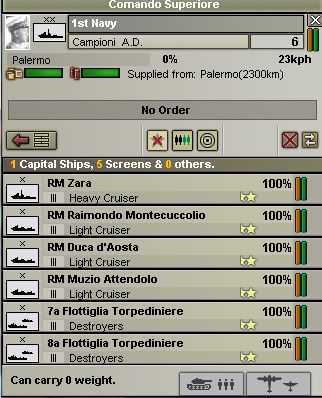
The proud ships of Campioni’s 1st Fleet.
Mussolini was not done handing Pintor naval assets, however. Commander Quilicci commanded Italy’s transport fleet of six transports, and these necessary ships also came under Pintor’s command. It is, after all, much harder to project power without an expeditionary capability such as that the transports provided. Additionally, Air Marshal Balbo’s three wings of naval bombers also reported to Pintor as well. Thus, Pintor became the command and administrative head of the core of Italy’s future expeditionary force. His force was a modest one, but Mussolini planned to expand it. Its position was, furthermore, significant: Naples, Palermo and Sardinia. Mussolini was looking west.
Pintor’s 7th Army, a truly joint force of land, air and sea units.
Even though, as argued, the majority of this first round of redeployments were for administrative purposes and make further redeployments easier to sort through, it is clear that Mussolini was already thinking ahead and arranging his forces accordingly. As noted, Pintor’s 7th Army quickly became the core of Mussolini’s strategy of power projection. Its joint expeditionary capabilities were at this point unique in the world, ahead of anybody else. It was a very attractive setup in theory. Mussolini was, however, concerned about how it would work in practice and waited eagerly for an opportunity to test it. This opportunity was to be long in coming.







